| Article ID | Journal | Published Year | Pages | File Type |
|---|---|---|---|---|
| 4412131 | Chemosphere | 2010 | 6 Pages |
Photo-Fenton oxidation followed by ferrite formation was applied for the degradation of a representative organic compound, phenol, and the subsequent removal of the Fe ions. At a phenol:Fe(II):H2O2 molar ratio of 1:0.5:15, TOC analysis showed almost complete mineralization of 10.6 mM phenol after 2 h at a controlled pH of 3. Recalcitrant low molecular weight organic acid by-products particularly oxalic acid were destroyed. A ferrous-rich solution was generated so that alkalinization at pH 10.5 generated a pitch black sludge of lower volume and moisture content than a ferric hydroxide control of the same Fe concentration. The flocs exhibited a strong affinity for a magnet and its X-ray diffraction pattern showed a close similarity to a standard spinel magnetite. With proper monitoring of Fe(II) and dissolved oxygen, the reaction was successfully controlled to generate flocs with more than 30% magnetite content. When photo-Fenton was employed as a pre-treatment step so that residual oxalic acid remained, ferrite formation was not inhibited. The presence of oxalates even allowed ferrites to form in a solution containing Ca2+ ions, which is well-known to be deterrent to the process.
